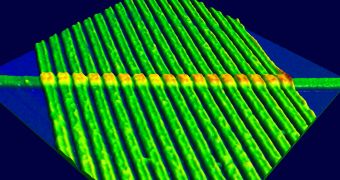The latest advances in the IT industry have been moving towards faster and faster chips which, at the same time, feature increasingly smaller die. The move may find itself slowed down at a certain point, as the chips will measure no more than a few atoms, yet there are some researchers that claim having found a solution. According to HP Labs in Palo Alto, CA, a new fundamental electronic component, called memristor, is able to ensure that the computer power will still be increasing at a rate we're accustomed to in the years to come.
Memristors surfaced in 1971, discovered by Berkeley professor Leon Chua. Basically, they are nanoscale devices which have unique properties, including variable resistance along with the ability to remember the resistance even when the power is off. Back in May, researchers at HP Labs managed to build the first working memristor. Last week, the team demonstrated the way memristors could be integrated into functioning circuits at the Memristor and Memristor Systems Symposium in Berkeley, CA. The circuits need fewer transistors, leaving more room for components to be packed into the same physical space while also reducing the power used to function.
“We're trying to give Moore's Law a boost,” says lead researcher Stan Williams, a senior research fellow at HP, while referring to a statement made by Intel founder Gordon Moore regarding the number of transistors on a computer circuit. According to Gordon Moore, the transistors should double roughly every two years, which would also double the computing power.
Up until now, a way to increase performance was represented by the shrinking of components so that more could be packed onto a circuit. Instead of doing so, the team eliminated some transistors and replaced them with fewer memristors. “We're not trying to crowd more transistors onto a chip or into a particular circuit,” Williams reveals. “Hybrid memristor-transistor chips really have the promise for delivering a lot more performance.”
Memristors act similar to resistors, only that they are able to change resistance depending on the amount and direction of the voltage that is applied to them, while also remembering the resistance after the voltage is turned off. This way, a single memristor is able to perform the functions of multiple transistors, which means they can increase computer power. Moreover, they could also prove a faster, smaller, more energy-efficient alternative to flash storage.
“Because memristors are made of the same materials used in normal integrated circuits,” says Williams, “it turns out to be very easy to integrate them with transistors”. His team, including HP researcher Qiangfei Xia, managed to build a field-programmable gate array (FPGA) with a new design that includes memristors made of the semiconductor titanium dioxide and far fewer transistors than normal.
FPGAs are commonly used for testing prototype chip designs as they allow reconfigurations for performing a wide variety of different tasks. Due to the fact that they are so flexible, FPGAs are large and expensive, while getting abandoned after the design is done. “When you decide what logic operation you want to do, you actually flip a bunch of switches and configuration bits in the circuit,” reveals Williams. In the new chip, these tasks are performed by memristors. “What we're looking at is essentially pulling out all of the configuration bits and all of the transistor switches,” he adds.
Williams also stated that using memristors in FPGAs could prove a great way to significantly lower costs. “If our ideas work out, this type of FPGA will completely change the balance,” he explains. At the moment, “the biggest impediment to getting memristors in the marketplace is having [so few] people who can actually design circuits [using memristors],” he adds. The next months will be crucial for memristor research, since they are predicted to arrive in commercial circuits within the next three years.

 14 DAY TRIAL //
14 DAY TRIAL //